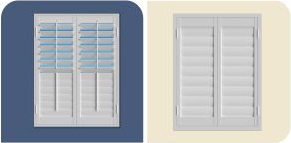
3 Ways Polywood Shutters Are Better Than Hollow Vinyl And Composite Shutters In Minneapolis, MN
December 15, 2015
Plantation shutters in Minneapolis come with different options. And when you are figuring out which non-wood shutter is best for you, it might be hard to discern the differences. You can unknowingly choose the wrong type and end up buying shutters that aren’t durable. When it comes to solid polymer shutters, like our best-selling Polywood® shutters, are they a better investment than MDF (multi-density fiberboard) or hollow vinyl shutters? Find out the three ways Polywood shutters are better than composite shutters in Minneapolis, MN so you can choose.
1. Polywood vs Composite Shutters Durability
Polywood shutters are fashioned from a top grade solid polymer that ensures the most color-retention, durability, and rigidity than any other shutter available. With that, the shutter louvers will not chip as long as they’re on the window. However, composite shutters are made from a pressed-board core, encapsulated in poly-vinyl. The vinyl wrapping the pressed board is likely to peel off from the core material readily. And this peeling is expedited in hot, humid, and wet climates. Non-wood shutters are also available as hollow vinyl shutters. But they disintegrate the fastest due to the elements.Both types of non-wood shutters are likely to warp and deteriorate when you consider all the climate conditions in Minneapolis. Polywood is manufactured with UV inhibitors that deflect heat. And with heat being the biggest problem in splitting the shutter louvers, Polywood is without a doubt the most durable plantation shutter you can buy.
2. Polywood vs Composite Shutters Color Fastness
Polywood shutters colors include three premium white paints. We bake our paint finishes on each piece at hotter temperatures than Minneapolis has seen. The patented finishing process applies UV inhibitors to ensure the color will never fade.
Other types of non-wood shutters come with low quality paint finish. And some composite shutters won’t even have any paint finish at all. In a lot of cases, the vinyl covering is the color you end up with. Yes, this finish appears to be adequate at first. But it fades over time. And when it comes to hollow vinyls, some are painted. However, with the material easily conducting heat, this adversely affects the finish over time.
3. Polywood vs Composite Shutters Energy Efficiency
Third party tests illustrate that Polywood shutters insulate against 30° of temperature and lead to reduction of heat transfer by up to 45%. With that, Polywood insulates up to 70% better than a similar solid wood shutter.
Polywood’s insulating properties are a result of the solid polymer material. However what makes Polywood even more energy efficient than composite shutters is the weatherstripping on louvers and panels. Just interlock the weatherstripping pieces when closing the panels and you get an airtight seal against the impact of the weather outside. You won’t find all the energy savings that Polywood offers in any composite shutter.
Our Vegas Team’s First Hand Experience With The Durability Of Polywood Shutters
In 2004, Sunburst Shutters Las Vegas had Polywood shutters fastened to the sides of their trucks as part of the graphics. The trucks were parked outside and endured all the weather conditions Nevada is known for. That means excessive heat for more than five months a year!
These Polywood shutters had been on our trucks for almost 7 years at that point. Our team conducted an investigation on how well Polywood retained the color painted on it. So we wiped the Polywood shutter that was on the truck clean. And we brought a new Polywood shutter and held it up next to it to compare. We found the color to be unchanged. There wasn’t any visible signs of fading or discoloration. It further validated for our team that our paint finish is the best in the market!
And with Polywood withstanding that much abuse and heat on the road for 7+ years, it’s undoubtedly the most durable shutter for your residence in Minneapolis, MN.


